

New data confirms: Neutrinos are still traveling faster than light. "It is worth pointing out, however, that the latest arXiv preprint lists 179 authors, while the original lists 174.
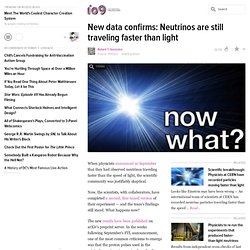
Would you ever classify five people as "most of" 15? To make things more confusing . . . "four new people" have decided not to sign, according to Science. Now, none of the above numbers may match up . . .. " The original 174 include a duplicate " F. The new 179 includes 10 new names that didn't appear on the old paper. Time warp: Researchers show possibility of cloning quantum information from the past. Cosmic Quandaries with Dr. Neil deGrasse Tyson. Time Travel? Don't Forget to Pack Your Wormhole. The concept of a time machine typically conjures up images of an implausible plot device used in a few too many science-fiction storylines.

But according to Albert Einstein's general theory of relativity, which explains how gravity operates in the universe, real-life time travel isn't just a vague fantasy. Traveling forward in time is an uncontroversial possibility, according to Einstein's theory. In fact, physicists have been able to send tiny particles called muons, which are similar to electrons, forward in time by manipulating the gravity around them. That's not to say the technology for sending humans 100 years into the future will be available anytime soon, though. Spooky Physics Phenomenon May Link Universe's Wormholes. Wormholes — shortcuts that in theory can connect distant points in the universe — might be linked with the spooky phenomenon of quantum entanglement, where the behavior of particles can be connected regardless of distance, researchers say.

These findings could help scientists explain the universe from its very smallest to its biggest scales. Scientists have long sought to develop a theory that can describe how the cosmos works in its entirety. Currently, researchers have two disparate theories, quantum mechanics and general relativity, which can respectively mostly explain the universe on its tiniest scales and its largest scales. There are currently several competing theories seeking to reconcile the pair. One prediction of the theory of general relativity devised by Einstein involves wormholes, formally known as Einstein-Rosen bridges. "This is true even when the electrons are light years apart," saidKristan Jensen, a theoretical physicist at Stony Brook University in New York. A Two-Time Universe? Physicist Explores How Second Dimension of Time Could Unify Physics Laws. For a long time, Itzhak Bars has been studying time.

More than a decade ago, the USC College physicist began pondering the role time plays in the basic laws of physics — the equations describing matter, gravity and the other forces of nature. Those laws are exquisitely accurate. In a "Rainbow" Universe Time May Have No Beginning. What if the universe had no beginning, and time stretched back infinitely without a big bang to start things off?
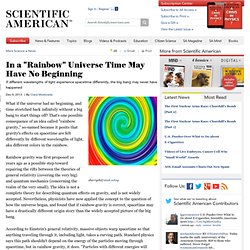
That's one possible consequence of an idea called "rainbow gravity," so-named because it posits that gravity's effects on spacetime are felt differently by different wavelengths of light, aka different colors in the rainbow. Rainbow gravity was first proposed 10 years ago as a possible step toward repairing the rifts between the theories of general relativity (covering the very big) and quantum mechanics (concerning the realm of the very small). The idea is not a complete theory for describing quantum effects on gravity, and is not widely accepted. Scientists Discover a Jewel at the Heart of Quantum Physics - Wired Science. Physicists reported this week the discovery of a jewel-like geometric object that dramatically simplifies calculations of particle interactions and challenges the notion that space and time are fundamental components of reality.

“This is completely new and very much simpler than anything that has been done before,” said Andrew Hodges, a mathematical physicist at Oxford University who has been following the work. The revelation that particle interactions, the most basic events in nature, may be consequences of geometry significantly advances a decades-long effort to reformulate quantum field theory, the body of laws describing elementary particles and their interactions.
New qubit control bodes well for future of quantum computing. (Phys.org)—Yale University scientists have found a way to observe quantum information while preserving its integrity, an achievement that offers researchers greater control in the volatile realm of quantum mechanics and greatly improves the prospects of quantum computing.
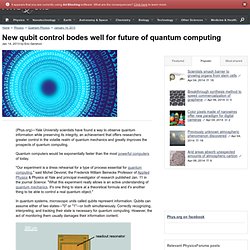
Quantum computers would be exponentially faster than the most powerful computers of today. "Our experiment is a dress rehearsal for a type of process essential for quantum computing," said Michel Devoret, the Frederick William Beinecke Professor of Applied Physics & Physics at Yale and principal investigator of research published Jan. 11 in the journal Science. "What this experiment really allows is an active understanding of quantum mechanics. It's one thing to stare at a theoretical formula and it's another thing to be able to control a real quantum object. " In quantum systems, microscopic units called qubits represent information. "As long as you know what error process has occurred, you can correct," Devoret said.
Photons detected without being destroyed. iStock/THINKSTOCK Measuring the properties of photons usually involves absorbing them, but a new device detects their passage and lets them fly by.

One of the cornerstones of quantum theory is the principle that you cannot measure any property of an object without affecting the object itself. Indeed, detecting the very existence of a photon until now has usually meant destroying it. Physicists, however, have now devised a way to detect single photons of visible light without bringing about their demise. Entanglement. Teleportation. Quantum boffins send data ACROSS TIME AND SPACE. Researchers in Israel have pulled a trick that makes quantum physics seem even stranger than an episode of Doctor Who – they've created a pair of photons that was briefly entangled not across space, but across time.
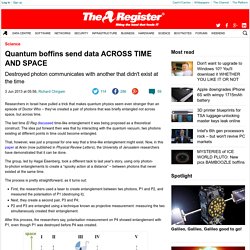
The last time El Reg discussed time-like entanglement it was being proposed as a theoretical construct. The idea put forward then was that by interacting with the quantum vacuum, two photons existing at different points in time could become entangled. That, however, was just a proposal for one way that a time-like entanglement might exist. Now, in this paper at Arxiv (now published in Physical Review Letters), the University of Jerusalem researchers have demonstrated that it can be done. The group, led by Hagai Eisenberg, took a different tack to last year's story, using only photon-to-photon entanglements to create a “spooky action at a distance” – between photons that never existed at the same time.
The process is pretty straightforward, as it turns out: Image: Phys. Physicists Create Quantum Link Between Photons That Don't Exist at the Same Time. Now they’re just messing with us.
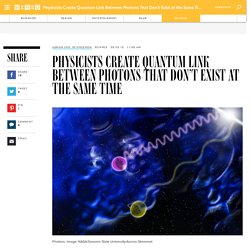
Physicists have long known that quantum mechanics allows for a subtle connection between quantum particles called entanglement, in which measuring one particle can instantly set the otherwise uncertain condition, or “state,” of another particle—even if it’s light years away. Now, experimenters in Israel have shown that they can entangle two photons that don’t even exist at the same time. “It’s really cool,” says Jeremy O’Brien, an experimenter at the University of Bristol in the United Kingdom, who was not involved in the work. Such time-separated entanglement is predicted by standard quantum theory, O’Brien says, “but it’s certainly not widely appreciated, and I don’t know if it’s been clearly articulated before.”
Physicists Create Quantum Link Between Photons That Don't Exist at the Same Time. Now they're just messing with us. Time Warp: Researcher Shows Possibility of Cloning Quantum Info from the Past. Popular television shows such as “Doctor Who” have brought the idea of time travel into the vernacular of popular culture. But the problem of time travel is even more complicated than one might think. LSU’s Mark Wilde has shown that it would theoretically be possible for time travelers to copy quantum data from the past. It all started when David Deutsch, a pioneer of quantum computing and a physicist at Oxford, came up with a simplified model of time travel to deal with the paradoxes that would occur if one could travel back in time. For example, would it be possible to travel back in time to kill one’s grandfather? In the Grandfather paradox, a time traveler faces the problem that if he kills his grandfather back in time, then he himself is never born, and consequently is unable to travel through time to kill his grandfather, and so on.